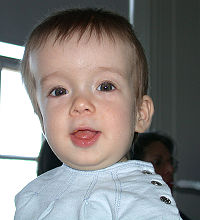
Photo from wikipedia
Background: Clinical findings in children with unilateral coronal craniosynostosis are characteristic, and therefore clinicians have questioned the need for confirmatory imaging. Preoperative computed tomographic imaging is a powerful tool for… Click to show full abstract
Background: Clinical findings in children with unilateral coronal craniosynostosis are characteristic, and therefore clinicians have questioned the need for confirmatory imaging. Preoperative computed tomographic imaging is a powerful tool for diagnosing associated anomalies that can alter treatment management and surgical planning. The authors’ aim was to determine whether and how routine preoperative imaging affected treatment management in unilateral coronal craniosynostosis patients within their institution. Methods: A retrospective, single-center review of all patients who underwent cranial vault remodeling for unilateral coronal craniosynostosis between 2006 and 2014 was performed. Patient data included demographics, age at computed tomographic scan, age at surgery, results of the radiographic evaluation, and modification of treatment following radiologic examination. Results: Of 194 patients diagnosed with single-suture craniosynostosis, 29 were diagnosed with unilateral coronal craniosynostosis. Additional radiographic anomalies were found in 19 unilateral coronal craniosynostosis patients (65.5 percent). These included severe deviation of the anterior superior sagittal sinus [n = 12 (41.4 percent)], Chiari I malformation [n = 1 (3.4 percent)], and benign external hydrocephalus [n = 2 (6.9 percent)]. The radiographic anomalies resulted in a change in management for 48.3 percent of patients. Specifically, alteration in frontal craniotomy design occurred in 12 patients (41.4 percent), and two patients (6.9 percent) required further radiographic studies. Conclusions: Although clinical findings in children with unilateral coronal craniosynostosis are prototypical, preoperative computed tomographic imaging is still of great consequence and continues to play an important role in surgical management. Preoperative imaging enabled surgeons to alter surgical management and avoid inadvertent complications such as damage to a deviated superior sagittal sinus. Imaging findings of Chiari malformation and hydrocephalus also permitted judicious follow-up. CLINICAL QUESTIONS/LEVEL OF EVIDENCE: Therapeutic, IV.
Journal Title: Plastic and Reconstructive Surgery
Year Published: 2021
Link to full text (if available)
Share on Social Media: Sign Up to like & get
recommendations!